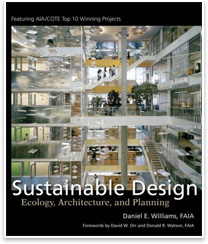
 Best Practices Best Practices Sustainable Design: A Definition, a Direction Summary: Daniel Williams’s new book, Sustainable Design, “is a description of a transition from the exclusive concern for form making to the art and science of place making,” says Oberlin College Professor David Orr in his foreword to the book. With a complete compendium of the 1997–2006 annual AIA Committee on the Environment Top 10 projects and bottom-up discussion of ecology and sustainability, the book conveys a powerful, much-needed message. Even its medium is its message: Sustainable Design is printed on 100 percent post-consumer recycled paper. Following is Williams’s definition of sustainable (versus green) design and a checklist of where to start. Green design versus sustainable design Green design is an element of sustainable design. Green buildings and communities that integrate the local climate and building resources, create healthy interior spaces with natural light, and complete recycling and reuse of materials are critical to the development of a sustainable future. Green buildings that efficiently use grid-based (non-renewable) energy slow the energy and pollution crisis, but if the energy sources powering these buildings are unsustainable, the design is not sustainable. Sustainable design differs from green design in that it is additive and inclusive—it includes continuing, surviving, thriving, and adapting. Green design incorporates ecologically sensitive materials and creates healthy buildings and processes that do not negatively affect the environment before, during, or after manufacture, construction, and deconstruction. Green design incorporates efficient mechanical systems and high-performance technologies but still functions primarily through the use of fossil fuels. Sustainable design integrates the principles of green design and goes further to become a passive and active structure that is designed to maximize the use of a site’s natural renewable resources. When buildings are conceived as organisms instead of objects, they become part of the ecological neighborhood, and, since they operate off existing site and regional renewable energies, they are sustainable. Sustainable design improves the quality of life while eliminating the need for nonrenewable energy. When a design solution incorporates sustainable energies to power that design’s function, that “work” is done for free. Free work is what natural systems provide; it powers all ecology. Human ecology, though similar, is critically different. Although largely powered by sustainable processes that provide essential needs, human settlements rely on fossil fuel for food, comfort, transportation, air, water, and security. Designs powered by free sustainable energies require no fossil fuel and are capable of providing a healthier level of comfort and a higher quality of life. In achieving this connection with local free energies, sustainable design reduces or eliminates the daily consumption of non-renewables, reduces project costs and maintenance costs and requirements, increases user approval and user productivity, and reduces the total embodied project energy. Sustainable design is green design powered by sustainable energies—functioning unplugged. Where to start
The following questions should be asked of design to gauge a project’s sustainability.
There are limits to all resources. Technological solutions often cause problems greater than those they were intended to solve, requiring additional cleanup, storage of toxic materials, and additional taxes to pay for such services. To achieve an interactive network of humanity and nature—a landscape that has a place for both the needs of humans and the functions of nature—planning and design must reorient themselves from using more to the view that there are limits. It then becomes the combined mission of science, planning, and design to discover these limits and work within them; to put form to a common vision and develop incremental steps and strategies on how to get from here to there. Copyright 2007 by John Wiley & Sons. All rights reserved. |
||
Copyright 2007 The American Institute of Architects. All rights reserved. Home Page |
||
home
news headlines
practice
business
design
recent related
› Sustainability Is in the Details
› Being Less Bad Is Not Being Good
› Just What Is Sustainability?
Sustainable Design: Ecology, Architecture, and Planning, published by John Wiley & Sons, will be released on Earth Day, April 22, 2007. For more information on the book, visit AIA.org.
For more Wiley publications on sustainable design, visit their Web site.
